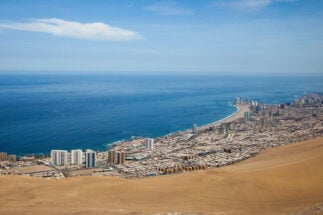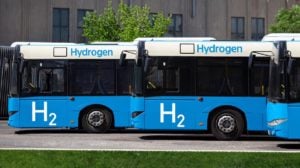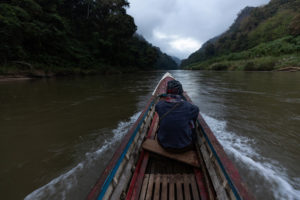Renewable energy sources play a central role for developing countries in their energy transitions, and Chile is no exception. Having made great strides in recent years, including a considerable growth in its solar capacity, the country now wants to export its energy to Asia – via a 20,000-kilometre cable under the Pacific Ocean.
If it sounds ambitious, that’s because it is: the Antípodas project, as it has been dubbed, is something that has never been done before at such scale. “This project will allow us to share with Asia Pacific countries the clean, reliable and renewable solar energy that we can produce in Chile during the daytime, to meet the electricity demand at night in some Asian countries, replacing polluting energy with clean and renewable energy,” Chile’s outgoing president Sebastián Piñera told a virtual leaders’ summit at the Asia-Pacific Economic Cooperation meeting last November.
“Through this project, we will be taking advantage of the distance between our countries, which is often seen as an obstacle to our integration, as an advantage that will allow us to produce and consume solar energy 24 hours a day,” he added.
The idea is to produce between 200 and 600 gigawatts (GW) in the Atacama desert – known as the world’s driest desert, and also one of the best places to generate solar energy on the planet due to its high solar radiation levels. This energy would then be exported to Asian countries via the new submarine cable.
The Chilean government claims that the project could also have the potential to reduce total global CO2 emissions by up to 4.5%, or more than 1.6 billion tonnes per year, by replacing polluting energy with renewable energy.
Before the virtual summit, Piñera spoke about the project at the 2021 National Business Meeting (Enade), held in the capital, Santiago, where he also assured that it is first necessary to carry out studies and create alliances with Asian nations for its realisation.
Feasibility of the project
Sources at the Ministry of Energy told Diálogo Chino that there is still no public information about the Antípodas project and that it is still under study. Even so, experts say it is not currently feasible for a number of reasons.
“No one can answer whether it is possible because there is no study to confirm it,” said Claudia Rahmann, director of the Solar Energy Research Center (SERC) and an academic at the University of Chile’s department of electrical engineering. There is also even more uncertainty around the significant size of this project, she adds, with few studies that can certify the stability and control necessary to operate it safely.

Meanwhile in the southern hemisphere, a 4,200km power cable between Australia and Singapore is being worked on, and is planned to be operational by 2027. But, again, the Australia–Asia Power Link would be less than a quarter of the length of the Antípodas. The two countries already share a 4,600km submarine communications cable, but transmitting power poses a different challenge.
“This may be an interesting idea in the long term, but we are a long way from the technology needed to realise it,” says Claudio Huepe, director of the Centre for Energy and Sustainable Development at the Diego Portales University.
The challenges ahead
The first major challenge is, perhaps unsurprisingly, the length of cable that would be needed, and the cost of sourcing it. Today, one kilometre of high-voltage direct current (HVDC) transmission line costs between US$1 million and US$3 million. That has to be multiplied by 15,000 to 20,000, Huepe says.
As an example, the British company Xlinks plans to build 10.5 GW of wind and solar power generation capacity in Morocco, to export energy to the UK via a 3,800-kilometre submarine cable. The whole project would cost in excess of US$24 billion.
Another crucial factor is security. Not only because the cable will be tens of thousands of kilometres long, but also because it will be in the depths of the Pacific Ocean. How would it be maintained?
“The question here is even if the cable were cheaper, would it really be justified to install it?” asks Álvaro Lorca, an engineering professor at Chile’s Catholic University. He points out that, as it would be so long, it would have considerable energy losses. A cable on land loses up to 5% of what is transmitted, but Antípodas, Lorca says, could lose more than 10% during transmission.
But on top of this, there is still the problem of power generation itself. Antípodas would supposedly transmit between 200 and 600 GW – in other words, up to 20 times the energy that Chile generates today.
According to data from Generadoras de Chile, the association of power generators, between June 2020 and June 2021, the nation added 1,900 MW of solar photovoltaic power, to increase the country’s installed solar capacity to 4,936 MW. With this, the share of solar power in the national system rose from 11.9% to 17.6%.
Meanwhile, wind power generation in the last year has grown by 538 MW of installed capacity, reaching a total of 2,602 MW, according to data from the National Electricity Coordinator. Both energy sources are part of the national strategy to achieve carbon neutrality by 2050.
It makes no sense to talk about a 20,000-kilometre cable when we are not even interconnected with our neighbours. Exporting to another continent is not a priority.
The figures are still some way off meeting the proposed output for the Antípodas project, but new projects continue to emerge in Chile. “There has been a big revolution with solar panels, and we are starting to incorporate concentrated solar [that uses mirrors to intensify radiation] into our generation as well, while we also have plans with green hydrogen,” Lorca says. “Antípodas could depend on how all this evolves.”
Still, to plan a project of this scale, you have to be sure of the technology – and the demand. “Both on the production side and on the demand side [in Asia], large investments must be made,” says Claudio Huepe.
But also, Álvaro Lorca adds, the cable has to work in both directions. The objective behind the project – that feeds its estimate of making important contributions to the reduction of CO2 emissions – is that it would be complementary to Asia’s own clean energy sources when they cannot generate, as is the case with solar energy at night. But the idea would also be for Asian countries to transmit clean energy back when it is dark in Chile.
“The problem is that the demand in our country is too small,” says the specialist, adding that it would make more sense to plan for a prior interconnection between South American countries. This could even become an earlier stage to test the technology.
Claudia Rahmann argues that talking about interconnection is very important, especially in the context of the world’s energy future, but “it makes no sense to talk about interconnection with a 20,000-kilometre cable when we are not even interconnected with our neighbours.” Argentina, Bolivia, Brazil and others could form, together with Chile, a large network that could take advantage of the country’s maximum solar potential. “Exporting energy to another continent is not among the current priorities,” she says.
Álvaro Lorca adds that although Antípodas is not feasible today, this does not necessarily mean that it will not be in the future – the distant future. Claudio Huepe is of the same opinion, and recalls that in the south of Chile the possibility of having a submarine cable parallel to the coast has already been studied, but it was discarded due to its complexity and cost.








